NVIDIA’s GeForce GTX 480 and GTX 470: 6 Months Late, Was It Worth the Wait?
by Ryan Smith on March 26, 2010 7:00 PM EST- Posted in
- GPUs
Compute
Update 3/30/2010: After hearing word after the launch that NVIDIA has artificially capped the GTX 400 series' double precision (FP64) performance, we asked NVIDIA for confirmation. NVIDIA has confirmed it - the GTX 400 series' FP64 performance is capped at 1/8th (12.5%) of its FP32 performance, as opposed to what the hardware natively can do of 1/2 (50%) FP32. This is a market segmentation choice - Tesla of course will not be handicapped in this manner. All of our compute benchmarks are FP32 based, so they remain unaffected by this cap.
Continuing at our look at compute performance, we’re moving on to more generalized compute tasks. GPGPU has long been heralded as the next big thing for GPUs, as in the right hands at the right task they will be much faster than a CPU would be. Fermi in turn is a serious bet on GPGPU/HPC use of the GPU, as a number of architectural tweaks went in to Fermi to get the most out of it as a compute platform. The GTX 480 in turn may be targeted as a gaming product, but it has the capability to be a GPGPU powerhouse when given the right task.
The downside to GPGPU use however is that a great deal of GPGPU applications are specialized number-crunching programs for business use. The consumer side of GPGPU continues to be underrepresented, both due to a lack of obvious, high-profile tasks that would be well-suited for GPGPU use, and due to fragmentation in the marketplace due to competing APIs. OpenCL and DirectCompute will slowly solve the API issue, but there is still the matter of getting consumer orientated GPGPU applications out in the first place.
With the introduction of OpenCL last year, we were hoping by the time Fermi was launched that we would see some suitable consumer applications that would help us evaluate the compute capabilities of both AMD and NVIDIA’s cards. That has yet to come to pass, so at this point we’re basically left with synthetic benchmarks for doing cross-GPU comparisons. With that in mind we’ve run a couple of different things, but the results should be taken with a grain of salt as they don’t represent any single truth about compute performance on NVIDIA or AMD’s cards.
Out of our two OpenCL benchmarks, we’ll start with an OpenCL implementation of an N-Queens solver from PCChen of Beyond3D. This benchmark uses OpenCL to find the number of solutions for the N-Queens problem for a board of a given size, with a time measured in seconds. For this test we use a 17x17 board, and measure the time it takes to generate all of the solutions.
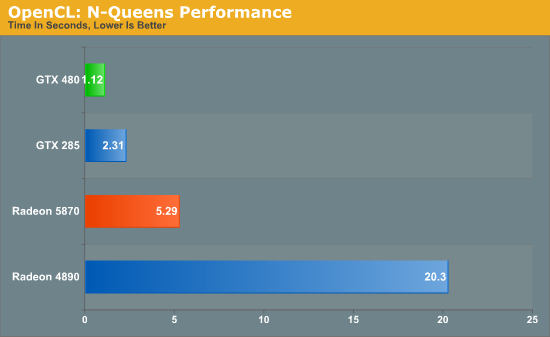
This benchmark offers a distinct advantage to NVIDIA GPUs, with the GTX cards not only beating their AMD counterparts, but the GTX 285 also beating the Radeon 5870. Due to the significant underlying differences of AMD and NVIDIA’s shaders, even with a common API like OpenCL the nature of the algorithm still plays a big part in the performance of the resulting code, so that may be what we’re seeing here. In any case, the GTX 480 is the fastest of the GPUs by far, beating out the GTX 285 by over half the time, and coming in nearly 5 times faster than the Radeon 5870.
Our second OpenCL benchmark is a post-processing benchmark from the GPU Caps Viewer utility. Here a torus is drawn using OpenGL, and then an OpenCL shader is used to apply post-processing to the image. Here we measure the framerate of the process.
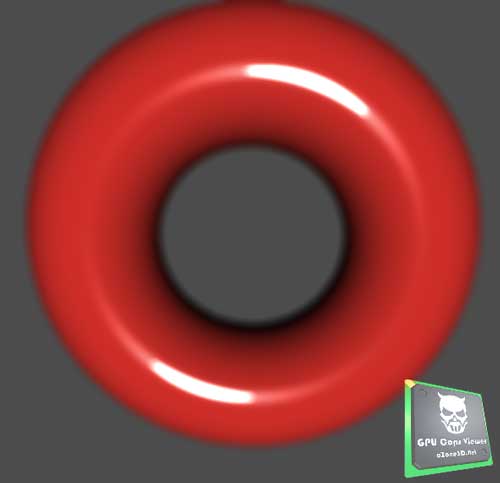
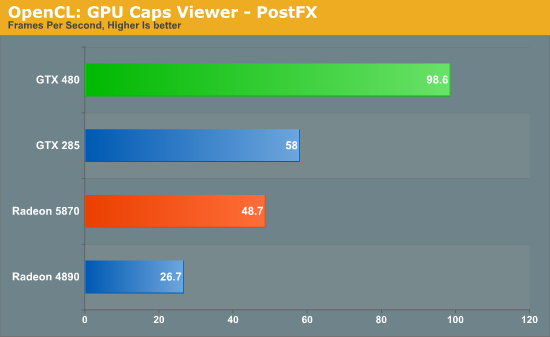
Once again the NVIDIA cards do exceptionally well here. The GTX 480 is the clear winner, while even the GTX 285 beats out both Radeon cards. This could once again be the nature of the algorithm, or it could be that the GeForce cards really are that much better at OpenCL processing. These results are going to be worth keeping in mind as real OpenCL applications eventually start arriving.
Moving on from cross-GPU benchmarks, we turn our attention to CUDA benchmarks. Better established than OpenCL, CUDA has several real GPGPU applications, with the limit being that we can’t bring the Radeons in to the fold here. So we can see how much faster the GTX 480 is over the GTX 285, but not how this compares to AMD’s cards.
We’ll start with Badaboom, Elemental Technologies’ GPU-accelerated video encoder for CUDA. Here we are encoding a 2 minute 1080i clip and measuring the framerate of the encoding process.
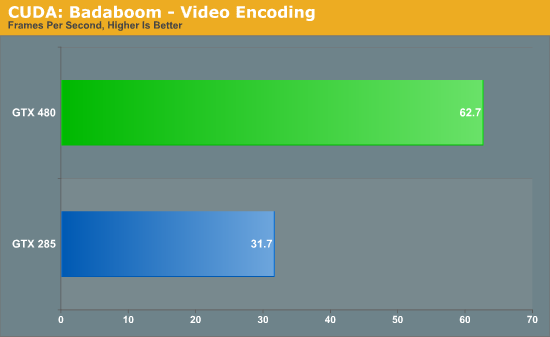
The performance difference with Badaboom is rather straightforward. We have twice the shaders running at similar clockspeeds, and as a result we get twice the performance. The GTX 480 encodes our test clip in a little over half the time it took the GTX 280.
Up next is a special benchmark version of Folding@Home that has added Fermi compatibility. Folding@Home is a Standford research project that simulates protein folding in order to better understand how misfolded proteins lead to diseases. It has been a poster child of GPGPU use, having been made available on GPUs as early as 2006 as a Close-To-Metal application for AMD’s X1K series of GPUs. Here we’re measuring the time it takes to fully process a sample work unit so that we can project how many nodes (units of work) a GPU could complete per day when running Folding@Home.

Folding@Home is the first benchmark we’ve seen that really showcases the compute potential for Fermi. Unlike everything else which has the GTX 480 running twice as fast as the GTX 285, the GTX 480 is a fewtimes faster than the GTX 285 when it comes to folding. Here a GTX 480 would get roughly 3.5x as much work done per day as a GTX 285. And while this is admittedly more of a business/science application than it is a home user application (even if it’s home users running it), it gives us a glance at what Fermi is capable when it comes to compuete.
Last, but not least for our look at compute, we have another tech demo from NVIDIA. This one is called Design Garage, and it’s a ray tracing tech demo that we first saw at CES. Ray tracing has come in to popularity as of late thanks in large part to Intel, who has been pushing the concept both as part of their CPU showcases and as part of their Larrabee project.

In turn, Design Garage is a GPU-powered ray tracing demo, which uses ray tracing to draw and illuminate a variety of cars. If you’ve never seen ray tracing before it looks quite good, but it’s also quite resource intensive. Even with a GTX 480, with the high quality rendering mode we only get a couple of frames per second.
On a competitive note, it’s interesting to see NVIDIA try to go after ray tracing since that has been Intel’s thing. Certainly they don’t want to let Intel run around unchecked in case ray tracing and Larrabee do take off, but at the same time it’s rasterization and not ray tracing that is Intel’s weak spot. At this point in time it wouldn’t necessarily be a good thing for NVIDIA if ray tracing suddenly took off.
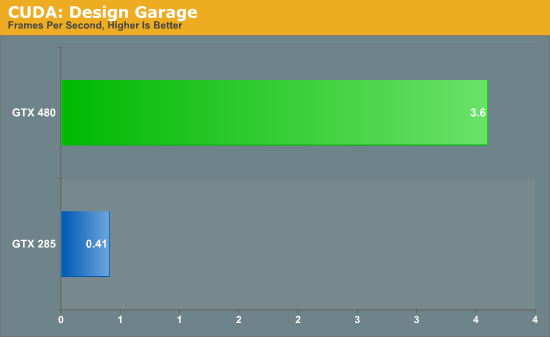
Much like the Folding@Home demo, this is one of the best compute demos for Fermi. Compared to our GTX 285, the GTX 480 is eight times faster at the task. A lot of this comes down to Fermi’s redesigned cache, as ray tracing as a high rate of cache hits which help to avoid hitting up the GPU’s main memory any more than necessary. Programs that benefit from Fermi’s optimizations to cache, concurrency, and fast task switching apparently stand to gain the most in the move from GT200 to Fermi.










196 Comments
View All Comments
Sunburn74 - Sunday, March 28, 2010 - link
It is absolutely ridiculous. Like having a buzzsaw in your case.http://www.hardocp.com/article/2010/03/26/nvidia_f...">http://www.hardocp.com/article/2010/03/26/nvidia_f...
Belard - Sunday, March 28, 2010 - link
AMD already stated they are not reducing their pricing any time soon. This is because their line-up is far healthier than Nvidia.They know (and we should know) that the $500/$350 price for the new GeForce 4 cards are not going to stick. There is only some many thousands of cards available for the next 3~5 months. The supply will run dry in about 1-3 weeks I bet. We're going to see the pricing shoot up close to $600 for the GF480, the fanboyz will be willing to pay that price.
The 5850 was supposed to be a $250 card, we see how well that worked out. While the price did settle around $300, the 5850 was still a better value than the $370~400 GeForce 285 card as it was far faster and run cooler, etc. The 5870 is typically faster than the $500 GeForce 295 - for $100 less. ATI has no reason to lower their pricing.
The GeForce 265~295 cards are already being phased out, too slow, cost too much.
So nVidia has nothing for the sub $300 market... nothing. Only the GF-250 has any value but a tad expensive as it should be $100 since its still a DX10 re-badged 9800GTX.
So when ATI feels any pressure from Nvidia, they can easily drop their prices. It costs $5000 per wafer, no matter how many chip dies are on it. It may be costing nVidia $150~200 per chip while for AMD, they could be paying $20~35 per chip used in the 5800/5900s.
Then you add the costs for memory, the PCB, parts, cooling system etc.
It is very easy for AMD to drop $50 per GPU and they'd still make a profit while Nvidia sells their geForce 400 cards at a loss or no profit.
When ATI sells the 5830 for $190~200, 5850 at $250 and 5870 at $325~350 would help sales and keep nVidia at bay.
We'll see...
SirKronan - Sunday, March 28, 2010 - link
I would've liked to see 5850's in crossfire thrown into this mix. I know you don't have time to test them all, but I think that's the key competitor against the 480 when it comes to bang/buck. I would think the 5850's in crossfire could handily beat the 295 and the 480, all while consuming less power. I believe there may have been another site that did it, but with this excellent and very thorough review done here, it would've been even that little tiniest bit sweeter to have a 5850 crossfire line on their graphs.Regardless, thanks for the informative review!
B3an - Saturday, March 27, 2010 - link
This review and any other pages on this site are not working in Firefox... they have been reported as attack pages."This web page at www.anandtech.com has been reported as an attack page and has been blocked based on your security preferences."
This is why FF with all default settings, and just using adlock.
Could it be trouble with the ads again using a malware/virus?
Ryan Smith - Sunday, March 28, 2010 - link
We know. It's being worked on.Sunburn74 - Saturday, March 27, 2010 - link
The 5850 idles inthe mid 30's but it also does absolutely nothing to stay cool, operating at about 20% max fan speed. Under load it may go up to 30% fan speed, but rarely ever breaks the 40% mark.What are the approximate idle and load fan speeds for both the gtx 480 and 470? I guess I'm asking this to understand just how much extra cooling room is innately available. Are these card working at max capacity to keep cool or is there thermal/fan headroom there to be had?
Ryan Smith - Saturday, March 27, 2010 - link
I don't have that data on-hand (we don't record fan speeds), but it's something that I should be able to easily grab at a later time.Lemonjellow - Saturday, March 27, 2010 - link
For some reason Chrome is flagging this article as a malicious sight... Oddness... Possibly got a bad advertisement...NJoy - Saturday, March 27, 2010 - link
well, Charlie was semi-accurate, but quite right =))What a hot chick... I mean, literately hot. Way too hotWiNandLeGeNd - Saturday, March 27, 2010 - link
Looking back at the data, I realized that power consumption is for system total. Guru3d measured the power consumption of the card itself and reported a max of 263W, so roughly 21 A. I think my 850W will do just fine since each PCI-X con has 20A each.